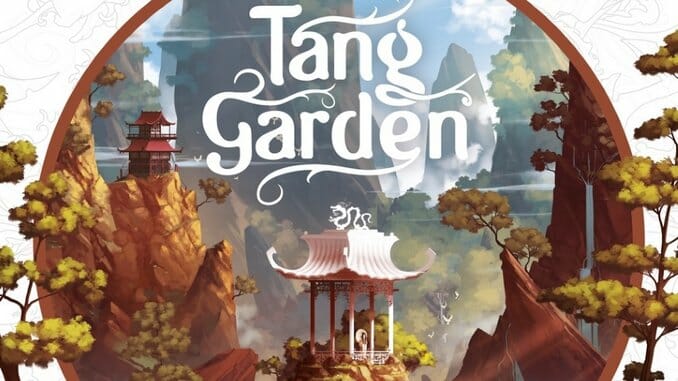
Tang Garden is an absolutely gorgeous game—the art is incredible, the components look great, and the game is hefty, weighing something like six pounds in a really large box. The game itself is certainly solid, asking you to think about a lot of variables but also giving you ample opportunity to do things, as you try to lay out vistas that match the desires listed on your specific character card. But as much as Tang Garden has going for it, I have to admit I didn’t feel drawn into the gameplay enough to want to play it again and again.
Tang Garden is set during that dynasty in Chinese history, which ruled for nearly three centuries until 900 CE. Players each start the game with a character card, showing one or two characteristics the character wants to see in the finished garden, both on the tiles between the character and the end of the board and on standing vista tiles around the four edges.
On your turn, you must either build the garden or place a decoration, and then you may take optional actions. To build, you take one of the four tiles shown on the four piles around the corners of the board, with each pile representing a different terrain type. You must place it next to a tile that’s already on the board. You must also place it in a way that all edges adjacent to tiles already on the board match—forest to forest, water to water, rock to rock, or pathway to pathway—moving up the respective markers on your resource tracker board or taking coins for pathways. If you place a tile on a square with a landscape token on it, you can then take a large or small vista piece and place it into one of the slots around the edges of the board, so that the characters who are eventually placed in the garden will see it if they’re facing in that direction.

Your other choice is to place a decoration on the board, which is one of the main ways you’ll gather points. You draw at least two cards from the decoration deck, choose one, and then place the depicted decoration on a matching space somewhere in the garden. The catch here is that you can draw more cards depending on the garden tile piles—when you take a tile, you don’t flip over the next one automatically, so there can be as many as four columns with face-down piles on top of them. When you take decoration cards, you take two plus one for each face-down tile on the four columns, so timing when to use this action is key. Decoration cards score for characters who have them in their line of sight, but their main point value comes from straight-up set collection—probably the most familiar mechanic in Tang Garden, as each card type scores in some unique way. You’ve seen this before in lots of games, like the Sushi Go! family.
As you move up the three trackers on your board, you’ll get opportunities to “influence” new characters with free actions. When all three of your markers reach certain columns, you’ll draw two character cards, choose one, and then add it to your hand. You then take one of your character cards and place its matching miniature on to one of the limited number of spaces on tiles that can hold a character, also choosing a direction for the figure to face. When the game ends, you’ll score each of your characters based on what they “see” in their line of sight as far as the landscape tiles, scoring for each decoration along the way and for the icons visible on all of those landscape tiles on that side of the board, up to five in total if all slots are filled. You can also use special lantern tiles you get at the start of the game to take special actions like placing two tiles in a turn or moving/reorienting a character on the board, although using those well assumes some knowledge of the game and probably becomes a lot more valuable with repeated plays.
The game ends when enough of the board is covered that there are three or fewer landscape tiles (placed at the start of the game) remaining, or when any of the piles of tiles are depleted. Then you score each player’s decoration cards, each player’s characters on the board based on what they “see,” and any coins they’ve gained during the game (such as from their resource trackers). The player with the highest total wins.
Tang Garden just looks fantastic, and there’s clear attention to detail in the artwork and the design of the miniatures. The components all seem very well-made as well. But I couldn’t get into the theme or spirit of the game at all, and I’m not quite sure why. Perhaps it’s because the idea of the characters “seeing” things didn’t work for the players—you can’t get down on their level and see the vistas they see because there will be other landscape tiles in the way. The scoring for the decoration cards is also too clichéd—so many games use that sort of set collection mechanic, like the aforementioned Sushi Go! games, or Point Salad, or several Stefan Feld games. I’m in the minority here—the game has very high ratings on Boardgamegeek, and has spawned two expansions that might address the game’s paucity of character cards and landscape tiles—but Tang Garden just didn’t live up to my admittedly high expectations for it.
Keith Law is the author of The Inside Game and Smart Baseball and a senior baseball writer for The Athletic. You can find his personal blog the dish, covering games, literature, and more, at meadowparty.com/blog.